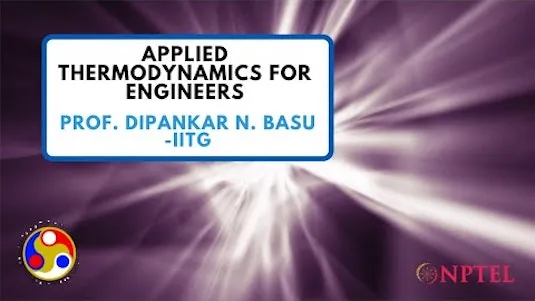
Non-Equilibrium Applications of Statistical Thermodynamics 
This course from the University of Colorado Boulder provides an introduction to Non-Equilibrium Applications of Statistical Thermodynamics, covering topics such as entropy, free energy, and chemical potential. ▼
ADVERTISEMENT
Course Feature
![]() Cost:
Cost:
Free
![]() Provider:
Provider:
Coursera
![]() Certificate:
Certificate:
No Information
![]() Language:
Language:
English
![]() Start Date:
Start Date:
Self Paced
Course Overview
❗The content presented here is sourced directly from Coursera platform. For comprehensive course details, including enrollment information, simply click on the 'Go to class' link on our website.
Updated in [March 06th, 2023]
This course provides an introduction to the non-equilibrium applications of statistical thermodynamics. It covers topics such as gases, solids, thermodynamics, liquids, and mechanical engineering. The course will focus on the fundamentals of thermodynamics and its applications to various systems.
The course will begin with an overview of the basic principles of thermodynamics, including the laws of thermodynamics, the first and second laws of thermodynamics, and the thermodynamic potentials. This will be followed by a discussion of the properties of gases, solids, and liquids, and their applications in thermodynamics.
The course will then move on to the study of non-equilibrium thermodynamics, including the study of the thermodynamic potentials, the thermodynamic equations of state, and the thermodynamic properties of systems in non-equilibrium. The course will also cover the study of the thermodynamic properties of systems in equilibrium, including the study of the thermodynamic potentials, the thermodynamic equations of state, and the thermodynamic properties of systems in equilibrium.
This course provides an introduction to the non-equilibrium applications of statistical thermodynamics. It is designed to provide students with a comprehensive understanding of the fundamentals of thermodynamics and its applications to various systems. Students will gain an understanding of the thermodynamic potentials, the thermodynamic equations of state, and the thermodynamic properties of systems in non-equilibrium and equilibrium. Upon completion of the course, students will be able to apply the principles of thermodynamics to solve problems in various fields, such as mechanical engineering, materials science, and chemical engineering.
[Applications]
The application of the concepts learned in this course on Non-Equilibrium Applications of Statistical Thermodynamics can be seen in various fields such as gases, solids, thermodynamics, liquids, and mechanical engineering. For example, the principles of thermodynamics can be used to analyze the behavior of gases and liquids in various systems. Additionally, the principles of thermodynamics can be used to design and analyze the performance of mechanical systems. Furthermore, the principles of thermodynamics can be used to analyze the behavior of solids in various systems. Finally, the principles of thermodynamics can be used to analyze the behavior of materials in various systems.
[Career Paths]
1. Mechanical Engineer: Mechanical engineers design, develop, build, and test mechanical and thermal sensors and devices, including tools, engines, and machines. They use a variety of engineering principles and technologies to create products that meet customer needs. With the increasing demand for energy efficiency and sustainability, mechanical engineers are in high demand to develop new technologies and products that meet these needs.
2. Thermal Engineer: Thermal engineers are responsible for designing and developing thermal systems and components, such as heat exchangers, boilers, and furnaces. They use their knowledge of thermodynamics and heat transfer to create efficient and cost-effective solutions for their clients. With the increasing demand for energy efficiency and sustainability, thermal engineers are in high demand to develop new technologies and products that meet these needs.
3. Process Engineer: Process engineers are responsible for designing and developing processes and systems for manufacturing and production. They use their knowledge of thermodynamics and heat transfer to create efficient and cost-effective solutions for their clients. With the increasing demand for energy efficiency and sustainability, process engineers are in high demand to develop new technologies and products that meet these needs.
4. Energy Engineer: Energy engineers are responsible for designing and developing energy systems and components, such as solar panels, wind turbines, and fuel cells. They use their knowledge of thermodynamics and heat transfer to create efficient and cost-effective solutions for their clients. With the increasing demand for energy efficiency and sustainability, energy engineers are in high demand to develop new technologies and products that meet these needs.
[Education Paths]
1. Mechanical Engineering: Mechanical engineering is a field of engineering that focuses on the design, construction, and operation of machines and mechanical systems. It is a rapidly growing field, with new technologies and applications being developed every day. Mechanical engineers are in high demand in many industries, including automotive, aerospace, energy, and manufacturing. As the world continues to become more technologically advanced, the need for mechanical engineers will continue to grow.
2. Thermodynamics: Thermodynamics is the study of energy and its transformation from one form to another. It is a branch of physics that deals with the behavior of matter and energy in a system. Thermodynamics is used to study the behavior of gases, liquids, and solids, and is essential for understanding the behavior of complex systems. It is also used to design and optimize energy systems, such as engines and power plants.
3. Materials Science: Materials science is the study of the structure, properties, and processing of materials. It is a multidisciplinary field that combines physics, chemistry, and engineering to understand the behavior of materials at the atomic and molecular level. Materials scientists use their knowledge to develop new materials and improve existing ones. This field is essential for the development of new technologies, such as nanotechnology, and is becoming increasingly important in the development of renewable energy sources.
4. Chemical Engineering: Chemical engineering is a field of engineering that focuses on the design and operation of chemical processes. It is a multidisciplinary field that combines chemistry, physics, and engineering to develop new processes and products. Chemical engineers are in high demand in many industries, including pharmaceuticals, energy, and food processing. As the world continues to become more technologically advanced, the need for chemical engineers will continue to grow.
Course Syllabus
A Molecular Picture of Dynamic Behavior
Simple Kinetic Theory of Dilute Gases
Transport Properties
The Boltzmann Equation and the Chapman- Enskog Solutions
Pros & Cons

Useful content

Practical exercises

Advanced exercises

Valuable

Difficult quizzes

Poor course organization

Wrong quiz answers

No guidance provided

Quiz issues.
Course Provider

Provider Coursera's Stats at AZClass
Discussion and Reviews
0.0 (Based on 0 reviews)
Explore Similar Online Courses

Challenges in Antibiotic Resistance: Gram Negative Bacteria

Skillshare Course Marketing

Python for Informatics: Exploring Information

Social Network Analysis

Introduction to Systematic Review and Meta-Analysis

The Analytics Edge

DCO042 - Python For Informatics

Causal Diagrams: Draw Your Assumptions Before Your Conclusions

Whole genome sequencing of bacterial genomes - tools and applications

Viscous Fluid Flow

Metamorphic Petrology & Thermodynamics

Applied Thermodynamics For Engineers
 Related Categories
Related Categories
 Popular Providers
Popular Providers
 Popular Searches
Popular Searches
Quiz
 Submitted Sucessfully
Submitted Sucessfully
1. What is the main focus of this course?
2. Which of the following is not a topic covered in this course?
3. What type of thermodynamics is covered in this course?
4. What is the main focus of Non-Equilibrium Applications of Statistical Thermodynamics?
Correct Answer: Gases, Solids, Thermodynamics, Liquids, and Mechanical Engineering


Start your review of Non-Equilibrium Applications of Statistical Thermodynamics